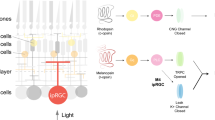Summary
Lumps of electron-dense material were observed in synaptic clefts associated with all types of photoreceptors, in the vicinity of the synaptic ribbons, in the retinae of dark-adapted frogs. Frogs were reared under a cyclic illumination (light on at 8:00; light off at 20:00) and then exposed to one of two courses of dark adaptation: one started from 11:00 in the morning, and the other started from 20:00 in the evening. The synaptic clefts of red rods became wider at some places where spherical or polygonal lumps of dense material were accumulated. The frequency and sectional area of the lumps increased faster for the first hour in the regime starting from 20:00 than in the regime starting from 11:00, then they reached the similar saturation levels of about 0.6 (per ribbon) and 1.6 to 1.8×104 (nm2) in both the regimes. In greenrod synapses, plate-shaped lumps of dense material were present in synaptic clefts and interspaces between the processes of second-order neurons. In cone synapses at the end of about 1 h darkness, the frequency and area of the lumps reached maximum values of about 0.12 (per ribbon) and 9×103 (nm2) in the regime starting from 11:00 and, about 0.08 (per ribbon) and 4 × 103 (nm2) in the regime starting from 20:00. On exposure to light, the dense material abruptly disappeared from all types of photoreceptor synaptic clefts. Large dense-core vesicles, occasionally observed in light-adapted rod photoreceptor terminals, seem to participate in exocytosis of the dense material. The number of dense-core vesicles per synaptic ribbon in a terminal was about 0.55 at the end of 3 h light in the morning and about 1.28 at the end of 12 h light in the evening. The increased number of dense-core vesicles during the daytime may contribute to the faster accumulation of dense material in the synaptic clefts. Although the chemical identification or the functional significance of the electron-dense material remains unknown, it is interesting that this material showed a rise and fall in response to darkness and illumination. Also the fact that this material is clearly visible will be helpful for future analysis of frog photoreceptor synapses.
Similar content being viewed by others
References
Byzov AL, Trifonov YA (1968) The response to electric stimulation of horizontal cells in the carp retina. Vision Res 8:817–822
Cervetto L, MacNichol EF jr (1972) Inactivation of horizontal cells in turtle retina by glutamate and aspartate. Science 178:767–768
Cervetto L, Piccolino M (1974) Synaptic transmission between photoreceptors and horizontal cells in the turtle retina. Science 183:417–419
Cooper NGF, McLaughlin BJ (1982) Structural correlates of physiological activity in chick photoreceptor synaptic terminals: Effects of light and dark stimulation. J Ultrastruct Res 79:58–73
Dowling JE (1968) Synaptic organization of the frog retina: An electron microscopic analysis comparing the retinas of frogs and primates. Proc R Soc Lond 170:205–228
Dowling JE, Ripps H (1973) Effects of magnesium on horizontal cell activity in the skate retina. Nature 242:101–103
Ehinger B (1981) 3H-D-aspartate accumulation in the retina of pigeon, guinea-pig and rabbit. Exp Eye Res 33:381–391
Evans EM (1966) On the ultrastructure of the synaptic region of visual receptors in certain vertebrates. Z Zellforsch 71:499–516
Kaneko A, Shimazaki H (1975) Effects of external ions on the synaptic transmission from photoreceptors to horizontal cells in the carp retina. J Physiol (Lond) 252:509–522
Lasansky A (1973) Organization of the outer synaptic layer in the retina of the larval tiger salamander. Philos Trans R Soc Lond 265:471–489
Monaghan P, Osborne MP (1975) Light-induced formation of dense-core vesicles in rod photoreceptors in retina of Xenopus laevis. Nature 257:586–587
Morjaria B, Voaden MJ (1979) The uptake of 3H-2-deoxyglucose by light- and dark-adapted rat retinas in vivo. J Neurochem 32:1881–1883
Murakami M, Ohtsu K, Ohtsuka T (1972) Effects of chemicals on receptors and horizontal cells in the retina. J Physiol (Lond) 227:899–913
Murakami M, Ohtsuka T, Shimazaki H (1975) Effects of aspartate and glutamate on the bipolor cells in the carp retina. Vision Res 15:456–458
Nilsson SEG (1964a) An electron microscopic classification of the retinal receptors of the leopard frog (Rana pipiens). J Ultrastruct Res 10:390–416
Nilsson SEG (1964b) Interreceptor contacts in the retina of the frog (Rana pipiens). J Ultrastruct Res 11:147–165
Osborne MP, Monaghan P (1976a) Effects of light and dark upon photoreceptor synapses in the retina of Xenopus laevis. Cell Tissue Res 173:211–220
Osborne MP, Monaghan P (1976b) Differential sensitivity of rods and cones in Xenopus retina to hemicholinium-3. Cell Tissue Res 175:59–72
Schacher SM, Holtzman E, Hood DC (1974) Uptake of horseradish peroxidase by frog photoreceptor synapses in the dark and the light. Nature 249:261–263
Schaeffer SF, Raviola E (1978) Membrane recycling in the cone cell endings of the turtle retina. J Cell Biol 79:802–825
Tomita T (1972) Light-induced potential and resistance changes in vertebrate photoreceptors. In: Fuortes MGF (ed) Handbook of sensory physiology. Bd. 7/2. Springer, Berlin Heidelberg New York, pp 483–511
Trifonov YA (1968) Study of synaptic transmission between the photoreceptor and the horizontal cell using electrical stimulation of the retina. Biophysics 13:948–957
Tsukamoto Y (1982) Arrangement of frog photoreceptor terminals and opaque material sojourning in synaptic clefts. Jpn J Ophthalmol 26:92
Underwood EE (1970) Quantitative stereology. Addison-Wesley, Massachusetts
Wagner H-J (1973) Darkness induced reduction of the number of synaptic ribbons in fish retina. Nature 246:53–55
Wagner H-J (1975) Quantitative changes of synaptic ribbons in the cone pedicles of Nannacara: Light dependent or governed by a circadian rhythm? In: Ali MA (ed) Vision in fishes. Plenum, New York, pp 679–686
Witkovsky P, Powell CC (1981) Synapse formation and modification between distal retinal neurons in larval and juvenile Xenopus. Proc R Soc Lond 211:373–389
Witkovsky P, Yang C (1982) Uptake and localization of 3H-2 deoxy-D-glucose by retinal photoreceptors. J Comp Neurol 204:105–116
Author information
Authors and Affiliations
Rights and permissions
About this article
Cite this article
Tsukamoto, Y. Light-related changes in electron-dense material in photoreceptor synaptic clefts of the frog, Rana catesbeiana . Cell Tissue Res. 234, 579–593 (1983). https://doi.org/10.1007/BF00218653
Accepted:
Issue Date:
DOI: https://doi.org/10.1007/BF00218653




